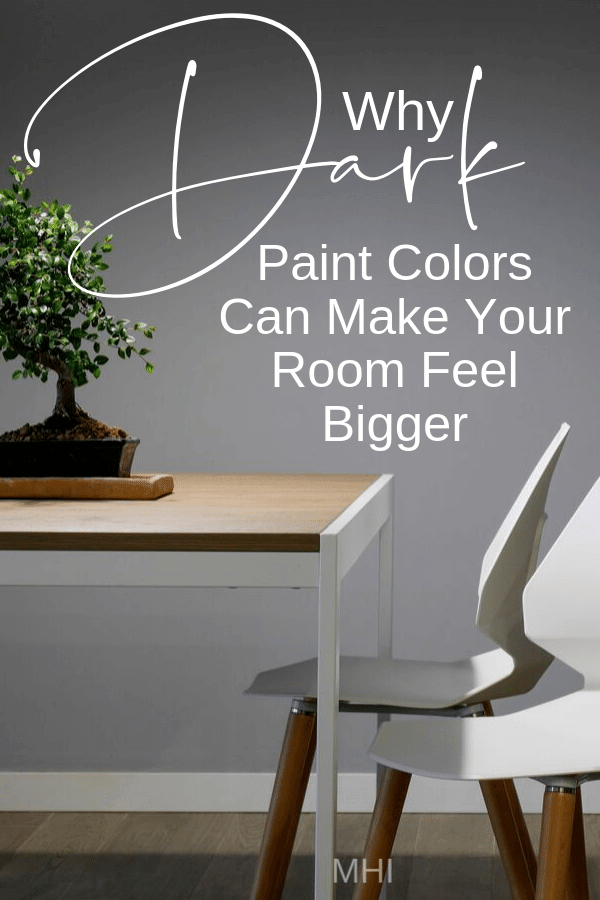Sandy sent me a text message a few weeks ago. I had designed a room plan for her based on her answers to my questionnaire and talking on video chat. We agreed that light and bright was the way to go for her small living room. When she received the plan, she loved it but couldn’t shake the feeling that a super white space just didn’t fit her vibe even though that is what she thought she wanted. She loves Scandinavian, clutter free looks that usually come with a healthy dose of ‘white’ and natural wood tones but, this just didn’t seem right for her. Sandy was experiencing a contradiction of style.
When we had the chance to reconnect, she told me that she prefers color but was afraid that being bold with the palate would make her space shrink and feel small. Why didn’t you say so?, I exclaimed. We can totally get you a colorful room that feels open and spacious despite being small.
It’s true that dark colors can recede and light colors can expand but, there are a few tricks that actually make a small room feel bigger with paint. Here’s a few things to keep in mind that really helped Sandy embrace her bold wall color choice:
1. Dark Paint, Light Furniture
If you love deep, rich color on the wall but still want your small room to feel bigger, consider going with a high contrast formula.
A good way to do this is by placing light furniture in a dark painted room. I used this trick in theater when I was a set manager years ago. The entire set is painted flat black and the foreground is styled and lit with stage lights to make the black room disappear. It worked like a charm, the corners disappear so focus was on the scene itself, not the space.
This theater painting technique will make a room look bigger too, minus the stage lights, usually… When you paint your small room dark and use high contrast furniture, the dark walls expand, blurring the lines in the background and the light furniture pops and adds dimension to the space.)
Take a look at this example: The white sectional is in high contrast to the dark blue wall. Hints of white are also picked up in the frames of the wall and accessories on the accent table. It’s dramatic, inviting and a bit energetic. If the wall was as white as the sectional, it would feel very sterile and clinical.
You can also paint your walls in a sophisticated charcoal gray, providing a deep and elegant backdrop. Paint in mustard yellow the wall that receives the most natural light or is directly visible when entering the room. This is a good recommendation from an experienced painting contractor. It's always good to seek an expert’s painting advice to make the best decision.
2. Match Window Treatments to The Wall Color:
If you want to create a truly layered look, add window treatments in the same color as the dark wall. A monochromatic color story gives a space dimension and allows for your furniture to be the star of the show.
I love the chocolate brown walls in this den. So cozy and inviting. Notice the drapes are the same color as the wall. If they were a lighter color or busy pattern, the entire vibe of the room would change. Instead of being relaxing and meditative, it would feel energetic and busy. Probably not the space you’d want to spend an afternoon hanging out with a good book.
3. Paint Trim the Same Color as the Wall:
Dark paint adds drama (I love to give the baseboards or skirting boards the same color treatment as the wall in small spaces. When the lower horizontal lines are minimized, the space will feel taller because your eye isn’t going directly to those details. A high contrast chair rail and baseboard color punctuates the space by creating visual lines that break up visual flow, don’t highlight them! The same is true for batten and board molding or paneled walls.
When all the lines below the ceiling are the same color, your eye naturally notices the height of the space. This is an important consideration when deciding on a paint color to make rooms look bigger.
Here, the magnificent deep gray covers the paneling and base trim flawlessly. The stark contrast of the white ceiling accentuates the height with contrast and drama. The furniture and everything see in the space is in similar tones amplifying and supporting the beautiful color story.
4. Horizontal Stripes in Contrasting Colors Add Width:
If you want to accomplish a longer room instead of a taller feeling room, try adding in some painted stripes. You can be bold and go for a high contrast look or you can be more subtle and paint stripes in the same color but in different paint finishes.
The affect will be the same: it makes a room appear wider. I would probably not paint all the walls in the room with this technique because it may start to look like a circus tent. I would reserve this for an accent wall or the longest wall without obstructions: doorways, fireplace, etc.
This example isn’t a traditional stripe but, the horizontal lines of triangles accomplish the same effect: they make the room appear wider. It also creates a bit of depth in the room. Notice how the charcoal and white from the wall is repeated in the bedding and crib. That’s a great way to reinforce a color story.
5. Match Furniture to Wall Color:
I always say, pick your paint color last and the way that you can make this small space look bigger is to match your wall color to your upholstery. This takes down the contrast and allows the upholstery to recede into the room.)
Keep your accents in the same color family without a lot of pattern – simplicity can do wonders for a small space to make it feel larger… If you’re going for a larger feeling in a space, keep your accents simple – simple patterns, not busy…
Take this monochromatic space. It works because everything is the same tone with very little contrast. This enables the room to feel relaxing and calm. Accents are kept neutral, so they don’t compete with the tranquility.
Conclusion:
There you have it, these are just a few techniques to make a small room feel bigger:
• Dark paint, light furniture
• Match Window Treatments to Wall Color
• Paint Trim the Same Color as the Wall
• Horizontal Stripes in Contrasting Colors Add Width
• Match Furniture to Wall Color
I’d love to hear what you think. Would you embrace a rich dark wall color in your small space? What color combinations have you tried that you really loved? Were there some that you didn’t like very much? Leave me a comment below and if you enjoyed this post don’t forget to give it a like.
Enjoying painting and want to try it out as a career? Try searching for painting jobs on Jooble company.
Need a bit more help picking your wall color? I created just the thing to help! The Perfect Paint Color Simplified, is my process to helping you get the exact right paint color for your space. It will walk you through my 5 simple steps that I use to determine the best paint colors for my clients and it woks like a charm, every time!
What you’ll Learn:
• The Best kept decorator secret that will save you tons and tons of time and stress when picking your wall color.
• Why it’s important to consider the geographic direction your room faces.
• The perfect tool to get you organized and inspired quickly and easily!
• How natural and artificial light effects color.
• The number one tool that all decorators and designers use to pick amazing paint colors and why you should too.
Here’s a few things to read next:
Furnishing a New House from Scratch? Here’s Five Tips to Keep You on Track
Mix it Up! Get the Skinny on Mixing Patterns, Texture and Scale for Your Living room
Thank you so much for reading. I can’t tell you how much I appreciate you spending your time with me! Until next week, stay amazing and keep your dreams big for your small space!
Michael is Principal designer and blogger at Michael Helwig Interiors in beautiful Buffalo, New York. Since 2011, he’s a space planning expert, offering online interior e-design services for folks living in small homes, or for those with awkward and tricky layouts. He’s a frequent expert contributor to many National media publications and news outlets on topics related to decorating, interior design, diy projects, and more. Michael happily shares his experience to help folks avoid expensive mistakes and decorating disappointments. You can follow him on Pinterest, Instagram and Facebook @interiorsmh.







